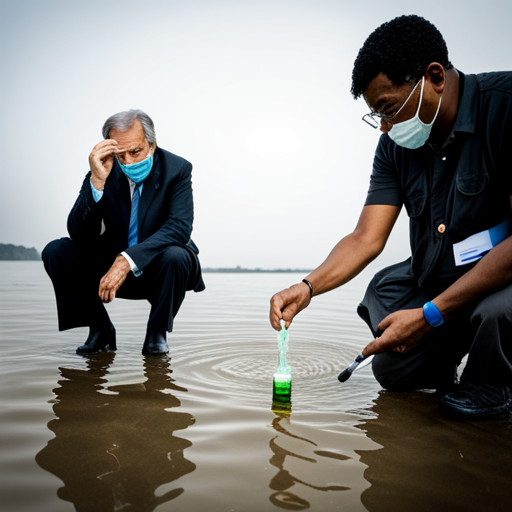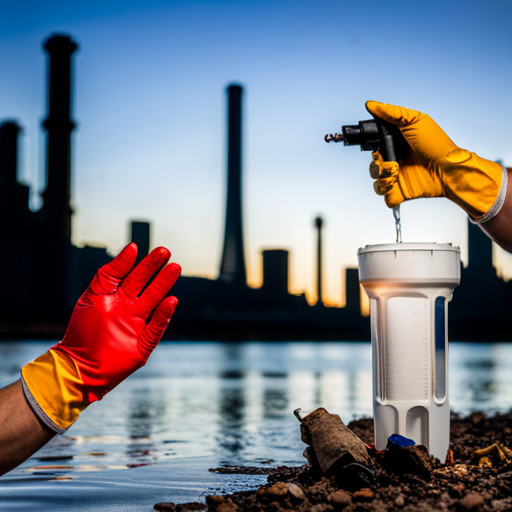The Invisible Enemy: Chronic Conditions from Extended Exposure to Toxic Water
This article examines the adverse health impacts resulting from prolonged exposure to contaminated water, an issue of increasing global concern.

It explores the correlation between toxic water and various chronic conditions, scrutinizes the role of government and health organizations in addressing water pollution, presents real-life experiences of affected individuals, and discusses potential preventive measures against toxic water exposure.
Key Takeaways
- Contaminated water can lead to waterborne diseases, chronic conditions, and bioaccumulation of harmful substances in the body.
- Industrial wastewater and pesticides used in agriculture are major sources of water pollution that can cause serious health issues.
- Governmental bodies and health organizations play a crucial role in implementing policies and strategies to mitigate the adverse effects of water pollutants.
- Public awareness, education, and investment in robust filtration systems are important preventive measures against toxic water exposure.
Understanding the Impact of Toxic Water on Human Health

Comprehension of toxic water's effect on human health necessitates an in-depth analysis of its short-term and long-term consequences, specifically with regard to the development of chronic conditions. Exposure to contaminated waters increases susceptibility to a wide spectrum of waterborne diseases, including cholera, typhoid, and dysentery. These illnesses are typically characterized by their acute onset and can have devastating impacts if left untreated.
However, the more insidious aspect is the cumulative effect of low-level exposure over extended periods. Prolonged contact with or ingestion of toxic water can lead to chronic conditions such as kidney damage, liver disease and various types of cancer. Regular consumption can also result in bioaccumulation - where harmful substances concentrate within biological organisms faster than they can be metabolized or excreted. This presents a long-lasting risk for those reliant on polluted water sources.
Mitigation strategies often involve filtering techniques designed to remove contaminants from drinking supplies. Techniques range from rudimentary charcoal filters that adsorb organic pollutants to sophisticated membrane technology capable of removing heavy metals and pathogenic microorganisms. However, these solutions are not always feasible due to cost constraints or lack of infrastructure.
Unveiling the Invisible Enemy: Chronic Conditions Linked to Water Pollution

Long-term health issues can be attributed to pollutants present in aqua resources, revealing the latent dangers of environmental contamination. Pollution sources vary widely, ranging from industrial waste discharge to agricultural runoff, each contributing a unique blend of toxins that infiltrate water supplies. Chronic exposure to such contaminants can instigate a host of health complications, including cardiovascular disease, neurological dysfunction and various forms of cancer.
Analyzing these pollution sources is paramount in developing effective health solutions. Industrial wastewater often contains heavy metals such as lead and mercury; prolonged ingestion or skin contact with these substances can result in serious neurological disorders. Similarly, pesticides utilized in agricultural practices often leach into ground and surface water bodies, leading to hormone disruption and carcinogenic effects when consumed over extended periods.
Health solutions need not only focus on combating existing ailments but also on preemptive measures aimed at reducing pollutant exposure. These include stringent regulation of industrial effluents and promotion of sustainable farming methods that minimize chemical use. Furthermore, investment towards robust filtration systems capable of eliminating myriad toxins is crucial for securing safe drinking water supplies.
Public awareness plays an equally significant role in mitigating this invisible enemy; understanding potential pollution sources empowers individuals to make informed decisions about their water consumption habits. Consequently, education regarding the link between chronic conditions and polluted water should be prioritized alongside technical interventions.
The Role of Government and Health Organizations in Combating Water Pollution

Effective management of environmental contamination rests heavily on the shoulders of governmental bodies and health organizations, which are tasked with implementing policies and strategies to mitigate the adverse effects of pollutants. These entities bear a significant level of organizational accountability as they navigate complex interplays between public health, environmental sustainability, and socio-economic considerations.
Policy evaluation plays a pivotal role in assessing the effectiveness and efficiency of these strategies. This entails an analytical review of policy objectives, implementation processes, resource allocation, stakeholder involvement, outcomes achieved vis-à-vis set targets among other aspects. It provides key insights into areas requiring improvement whilst identifying successful interventions that can be replicated or scaled up.
Moreover, stringent regulatory frameworks must be instituted to enforce compliance with established standards for water quality. Such regulations should encompass not only punitive measures for non-compliance but also incentives to promote best practices in pollution control. The role of scientific research cannot be underestimated in this regard; providing data-driven evidence that guides policy formulation and decision-making.
Governmental bodies need to foster strong partnerships with health organizations for effective surveillance systems to monitor potential outbreaks linked to water pollution. Such collaborations would enhance early detection and prompt response thereby minimizing detrimental impacts on public health.
Real-life Stories: Experiences of Individuals Affected by Chronic Conditions

Analyzing narratives from individuals grappling with persistent health issues provides critical insights into the lived experiences and challenges encountered in their daily lives. Personal narratives of those exposed to polluted water sources give a human face to the often abstract statistics on chronic diseases. These stories serve as powerful tools for understanding the complex interplay between environmental factors, individual health status, and societal dynamics.
Research indicates that exposure to toxic water can result in a range of long-term health conditions including cancers, neurological complications, and gastrointestinal disorders. The emotional impact inflicted is significant; it encompasses not only physical suffering but also psychological distress induced by constant uncertainty, fear, and the loss of normalcy.
Personal narratives offer an intimate exploration into these realities. They reveal how people navigate healthcare systems while managing crippling symptoms; they expose the strain on familial relationships; they highlight resilience amidst adversity. However, personal narratives should not be seen merely as anecdotal evidence – they are crucial data points that capture socio-economic disparities, systemic failures, and cultural beliefs that may influence disease outcomes.
Furthermore, these narratives can stimulate public empathy and policy changes by showcasing real-life struggles behind dry scientific facts about water pollution-induced illness. By engaging with these personal stories instead of solely relying on quantitative measures like morbidity rates or pollutant levels - we gain a more holistic understanding of this multifaceted problem.
Preventive Measures: How to Protect Yourself From Toxic Water Exposure

Preventive strategies can significantly mitigate the risk of health complications associated with contamination in water sources. Among these, advanced water filtration methods stand out as a viable solution for ensuring safe and clean drinking water.
Water filtration methods vary widely, ranging from activated carbon filters to reverse osmosis systems. Activated carbon filters effectively reduce certain contaminants such as chlorine, sediment, volatile organic compounds (VOCs), taste and odor. However, they are not effective against heavy metals, fluoride, bacteria or viruses. On the other hand, reverse osmosis systems offer extensive purification by removing a larger number of contaminants including lead, arsenic and copper among others. Despite their effectiveness in eliminating harmful substances from water sources, these methods have been criticized due to cost implications and maintenance requirements.
The bottled water debate is another crucial aspect in this discussion. The perception that bottled water is purer than tap has driven its high demand globally despite environmental concerns related to plastic waste and carbon emissions during production processes. Further scrutiny reveals that regulation standards for bottled water are often less stringent than those for tap water which may result in potential exposure to harmful chemicals contained within plastic bottles.
Frequently Asked Questions
What Are the Long-Term Economic Impacts of Water Pollution on Communities?
Long-term economic impacts of water pollution on communities include increased healthcare costs due to health implications, reduced productivity from illness, and potential depreciation in property values related to pollution costs.
How Does Water Pollution Affect the Life Cycles and Populations of Aquatic Organisms?
Water pollution disrupts the life cycles of aquatic organisms, leading to population decline. The resilience against pollution varies among species; while some develop survival strategies, others succumb to toxic environments, causing ecological imbalance.
What Are Some Technological Solutions Being Developed to Combat Water Pollution?
Technological solutions to combat water pollution include the development of advanced pollution filtering systems and sustainable sanitation methods. These technologies aim to remove harmful contaminants, ensuring safe, clean water for both human consumption and aquatic ecosystems.
How Is the Quality of Drinking Water Monitored and Regulated Globally?
The regulation and monitoring of global drinking water quality are guided by Water Sanitation Policies and Global Water Standards, which involve periodic testing, adherence to safety protocols, and implementation of corrective measures when necessary.
Can Prolonged Exposure to Contaminated Water Lead to Genetic Mutations or Changes?
Prolonged exposure to contaminated water may indeed precipitate genetic mutations or changes. Effective mutation prevention often hinges on rigorous contaminant removal from water supplies, safeguarding the genetic integrity of exposed populations.
Conclusion
In conclusion, the correlation between chronic conditions and prolonged exposure to polluted water necessitates immediate intervention. Governmental bodies and health organizations must intensify efforts to combat water pollution and educate individuals on preventive measures against toxic water exposure.
Chronic conditions as a consequence of contaminated water are an invisible enemy, requiring comprehensive research for effective solutions. The experiences shared by affected individuals underline the urgency of this global environmental health crisis.

This post has been generated by AI and was not reviewed by editors. This is Not legal advice. Please consult with an attorney.




